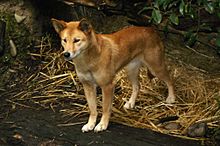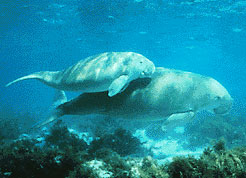Mammals of Australia facts for kids
The mammals of Australia are truly special! This amazing country is home to many different kinds of mammals. Most of them are marsupials, which are animals that carry their babies in a pouch. But Australia also has monotremes, which are mammals that lay eggs, and placental mammals, like us, who give birth to live young.
Many Australian marsupials look and act like placental mammals found in other parts of the world, even though they are not closely related. This is called convergent evolution. For example, the extinct Tasmanian tiger looked a lot like a wolf. Also, gliding possums are similar to flying squirrels, and the numbat is like an anteater. Most of Australia's mammals eat plants or a mix of plants and animals.
Contents
Australia's Mammal History
The story of Australia's mammals goes back a very long time!
Ancient Egg-Layers
Monotremes, the egg-laying mammals, have lived in Australia for a super long time. Fossils show they were here as far back as the Early Cretaceous period, which was about 145 to 99 million years ago.
Marsupials Arrive
Marsupials probably arrived in Australia around 64 to 65 million years ago. However, the oldest clear marsupial fossils found in Australia are from about 25 million years ago.
Placental Mammals Join In
Clear evidence of placental mammals in Australia starts from the Miocene period. This was when Australia began moving closer to Indonesia. About 15 million years ago, bats started appearing in the fossil record. Then, about 5 to 10 million years ago, rodents arrived.
Later, humans brought more placental mammals. About 1 million years ago, rats came. Then, about 40,000 years ago, humans themselves arrived. The dingo came about 5,000 years ago. Finally, about 200 years ago, European settlers brought many more species.
Some scientists once thought they found very old placental mammal fossils from Australia, called Tingamarra. But other researchers have questioned if these fossils are really that old or even from a placental mammal.
Monotremes and Marsupials: Unique Australian Mammals
Australia is famous for its unique mammals!
Monotremes: Mammals That Lay Eggs
Monotremes are super special because they are mammals that lay eggs! Only two of the five living monotreme species are found in Australia: the platypus and the short-beaked echidna.
The platypus is one of the strangest animals on Earth. It lays eggs, has a duck-like bill, webbed feet, and is venomous! When people in England first saw a platypus pelt, they thought it was a trick.
The short-beaked echidna is another odd monotreme. It's covered in hairy spikes and has a long, tube-like snout instead of a mouth. Its tongue can dart in and out about 100 times a minute to catch termites.
Marsupials: Mammals with Pouches
Australia has the most kinds of marsupials in the world. These are mammals that carry and raise their young in a special pouch.
- Meat-Eating Marsupials
The marsupial carnivores include the Dasyuridae family, with 51 different members, and the Myrmecobiidae family, which only has the numbat.
The thylacine, also known as the Tasmanian tiger, was the biggest meat-eating marsupial. Sadly, the last known one died in 1936. The largest meat-eating marsupial alive today is the Tasmanian devil. It's about the size of a small dog. Tasmanian devils became extinct on mainland Australia about 600 years ago and now only live in Tasmania.
There are four species of quoll, or "native cats," and all of them are now endangered. Most other Dasyuridae are called "marsupial mice" and weigh less than 100 grams.
Two species of marsupial mole live in the deserts of Western Australia. These rare, blind, earless carnivores spend most of their lives underground. Not much is known about them.
- Omnivorous Marsupials
Marsupial omnivores eat both plants and animals. This group includes the bandicoots and bilbies. There are seven species in Australia, and most are endangered. These small animals have plump bodies, long snouts, big upright ears, and thin tails. Scientists are still learning about how this group evolved.
- Plant-Eating Marsupials
The marsupial herbivores include the koalas, wombats, possums, kangaroos, and wallabies.

The koala is one of Australia's most famous marsupials. It lives in trees and eats the leaves of eucalyptus trees. Wombats, on the other hand, live on the ground and eat grasses, sedges, and roots. Wombats use their strong front teeth and claws to dig long tunnels underground. They are mostly active at dawn, dusk, or night. Wombats are also known for their pouch opening backwards! The extinct marsupial lion was a meat-eating wombat relative.
Possums are a diverse group of tree-dwelling marsupials. There are 26 species in six families. They range in size from the tiny pygmy possum, which weighs only 7 grams, to the cat-sized ringtail and brushtail possums.
The sugar and squirrel gliders are common gliding possums found in eastern Australia. The feathertail glider is the smallest glider. Gliding possums have special skin flaps, called "patagia," that stretch between their front and back legs. When they spread these flaps, they can glide from tree to tree!
Kangaroos, wallabies, and related species are found all over Australia, except in very cold mountain areas. The smallest is the musky rat-kangaroo. Most kangaroos and wallabies move by hopping on two legs, which saves energy. They have strong tails and large hind legs with long, narrow feet. The male red kangaroo is the largest, growing up to 2 meters tall and weighing up to 85 kilograms.
Placental Mammals in Australia

Australia has two main groups of native placental mammals: bats and mice and rats. Bats and rodents arrived in Australia more recently than marsupials. Bats probably came from Asia, and their fossils are only found from about 15 million years ago. While 7% of the world's bat species live in Australia, only two types of bats are unique to Australia.
Rodents first arrived in Australia about 5 to 10 million years ago. They then evolved into many different species, called the "old endemics." About a million years ago, another type of rat came from New Guinea and evolved into seven species of Rattus, known as the "new endemics."
Introduced Placental Mammals
Since humans settled in Australia, many placental mammals have been brought to the country and now live in the wild. The first was the dingo, which people from the north brought to Australia about 5,000 years ago.
When Europeans came to Australia, they intentionally released many animals into the wild. These included the red fox, brown hare, and the European rabbit. Other farm animals escaped and formed wild populations, such as cats, fallow deer, rusa deer, chital, domestic horses, donkeys, pigs, domestic goats, water buffalos, and dromedary camels. Only three non-native placental mammals arrived in Australia without being purposely released: the house mouse, black rat, and brown rat.
Marine Mammals

Forty-six species of marine mammals, like whales and dolphins, live in Australian coastal waters. Many of these species are found all over the world. There are nine species of baleen whales, including huge humpback whales and southern right whales. Dwarf minke whales are often seen near the Great Barrier Reef in winter.
There are 37 species of toothed whales, which include different kinds of beaked whales and 21 species of oceanic dolphin. The Australian snubfin dolphin was first described in 2005 and is only found in Australia. Some dolphins, like the orca, live in all waters around Australia. Others, like the Irrawaddy dolphin, prefer the warm northern waters.
The dugong is an endangered marine mammal that lives in the waters of northeastern and northwestern Australia, especially in the Torres Strait. It can grow up to 3 meters long and weigh as much as 400 kilograms. The dugong is the only plant-eating marine mammal in Australia, feeding on sea grass in coastal areas.
Ten species of seals and sea lions live off the southern Australian coast and in Australia's Sub-Antarctic territories.
Conserving Australian Mammals
Australia's mammals are very special and unique, so it's super important to protect them! Many of these animals are found nowhere else on Earth.
Here are some ways people are working to save them:
- Safe Havens: Creating special areas that are free from predators like cats and foxes. These predators have caused many native species to decline.
- Habitat Protection and Restoration: Protecting national parks, reserves, and private lands. This helps keep natural ecosystems healthy for the animals. It includes planting trees, stopping erosion, and managing fires so habitats stay suitable.
- Breeding Programs: Raising animals in zoos or special centers, then releasing them back into the wild. This helps increase their numbers. Scientists do a lot of research to make sure these programs give the animals the best chance to survive.
Because ecosystems are always changing, and challenges like climate change exist, conservation plans need to be flexible. This means regularly checking if conservation actions are working and being ready to change approaches based on new scientific discoveries and environmental changes.

